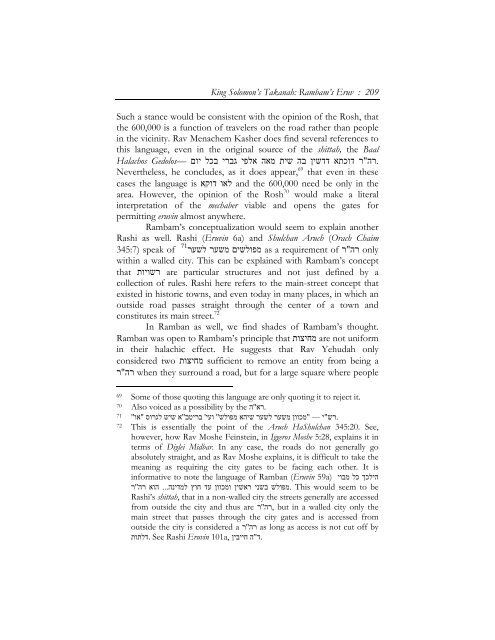King Solomon's Takanah: Rambam's Eruv - Hakirah.org
King Solomon's Takanah: Rambam's Eruv - Hakirah.org
King Solomon's Takanah: Rambam's Eruv - Hakirah.org
You also want an ePaper? Increase the reach of your titles
YUMPU automatically turns print PDFs into web optimized ePapers that Google loves.
<strong>King</strong> Solomon’s <strong>Takanah</strong>: Rambam’s <strong>Eruv</strong> : 209<br />
Such a stance would be consistent with the opinion of the Rosh, that<br />
the 600,000 is a function of travelers on the road rather than people<br />
in the vicinity. Rav Menachem Kasher does find several references to<br />
this language, even in the original source of the shittah, the Baal<br />
Halachos Gedolos—<br />
"<br />
Nevertheless, he concludes, as it does appear, 69 that even in these<br />
cases the language is לאו דוקא and the 600,000 need be only in the<br />
.רה ר דוכתא דדשין בה שית מאה אלפי גברי בכל יום<br />
area. However, the opinion of the Rosh 70 would make a literal<br />
interpretation of the mechaber viable and opens the gates for<br />
permitting eruvin almost anywhere.<br />
Rambam’s conceptualization would seem to explain another<br />
Rashi as well. Rashi (<strong>Eruv</strong>in 6a) and Shulchan Aruch (Orach Chaim<br />
71<br />
345:7) speak of מפולשים משער לשער as a requirement of "ר only<br />
within a walled city. This can be explained with Rambam’s concept<br />
that רשויות are particular structures and not just defined by a<br />
collection of rules. Rashi here refers to the main-street concept that<br />
existed in historic towns, and even today in many places, in which an<br />
outside road passes straight through the center of a town and<br />
constitutes its main street. 72<br />
In Ramban as well, we find shades of Rambam’s thought.<br />
Ramban was open to Rambam’s principle that מחיצות are not uniform<br />
in their halachic effect. He suggests that Rav Yehudah only<br />
considered two מחיצות sufficient to remove an entity from being a<br />
when they surround a road, but for a large square where people רה "ר<br />
69 Some of those quoting this language are only quoting it to reject it.<br />
70 .רא "ה Also voiced as a possibility by the<br />
71<br />
" 71<br />
. רש "י — 72 This is essentially the point of the Aruch HaShulchan 345:20. See,<br />
however, how Rav Moshe Feinstein, in Iggeros Moshe 5:28, explains it in<br />
terms of Diglei Midbar. In any case, the roads do not generally go<br />
absolutely straight, and as Rav Moshe explains, it is difficult to take the<br />
meaning as requiring the city gates to be facing each other. It is<br />
הילכך כל מבוי 59a) informative to note the language of Ramban (<strong>Eruv</strong>in<br />
"ר<br />
. This would seem to be Rashi’s shittah, that in a non-walled city the streets generally are accessed<br />
from outside the city and thus are "ר , but in a walled city only the<br />
main street that passes through the city gates and is accessed from<br />
outside the city is considered a "ר as long as access is not cut off by<br />
101a, See Rashi <strong>Eruv</strong>in .דלתות<br />
" רה<br />
רה<br />
"מכוון משער לשער שיהא מפולש" ועי' בריטב"א שיש לגרוס "או<br />
מפולש בשני ראשין ומכוון עד חוץ למדינה... הוא רה<br />
רה<br />
.ד ה חייבין
















